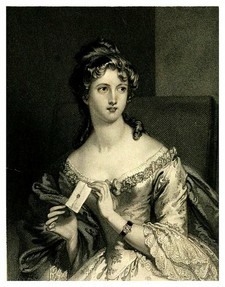 22 Hans Square was actually a boarding school, but a bed wasn't required for a five year old living three doors away.
22 Hans Square was actually a boarding school, but a bed wasn't required for a five year old living three doors away.
At first, Letitia merely delighted in her surroundings, found much to thrill her mind, then went home to Mum and Dad when classes were over for the day. It seems to have not been - nor caused - any hardship that she was not only so young, but ten years the junior of every other girl there.
Perhaps Mrs Rowden tailored her lessons accordingly. Maybe Letitia simply could keep up. The clue might be in what happened next.
In 1809, when she was seven years old, her father reached a decision about his lot. He had been in the military, but now determined that he was going to make a go of farming. Not in his native Herefordshire - that would be too humiliating - but back in Trevor Park, Hertfordshire. The Landon house in Hans Square was packed up and the whole family came with him.
Letitia was not impressed. She was far away from where she wanted to be, and she was bored.
Her father called upon his niece, Elizabeth Landon, to move in with them. She was his brother Samuel's daughter and a well educated young lady of nineteen years old. Perfect for acting as a governess for little Letitia. Or so he thought.
The reality quickly asserted itself. Letitia was simply too intelligent. At seven, she'd already far out-stripped her adult cousin. Elizabeth was magnanimous about it. In fact, she appeared downright proud of her young charge, later recalling,
'In very many instances, in endeavoring to teach, I have myself been taught, the extraordinary memory and genius of the learner soon leaving the humble abilities of the teacher far behind.'
The seven year old had already memorized massive sections of Sir Walter Scott's The Lady of the Lake, especially the battle scenes, which she recited with malice aforethought into her brother's face. She was reading Keats, Byron and Petrarch; devouring Robinson Crusoe and the Arabian Nights; and traveling to Africa, via her imagination, as prompted by travel books.
Her family gave up and sent her back to 22 Hans Square as a boarder.
For the rest of her life, she would consider her school to be home. Letitia refused point blank to graduate. As she grew into an adult, her travels might take her halfway across the world, but when she returned to Britain, it was to the school, not her family home.


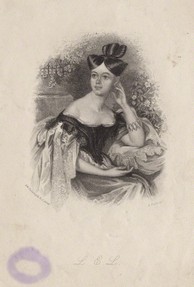 There was always something a little bit special about Letitia Landon. For a start, she learned to read while still a toddler.
There was always something a little bit special about Letitia Landon. For a start, she learned to read while still a toddler.

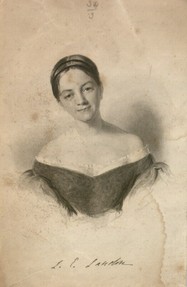 Letitia's precocious genius did not end in toddlerhood. By 1807, she was so desperate for intellectual stimulation, that her parents enrolled her in a school.
Letitia's precocious genius did not end in toddlerhood. By 1807, she was so desperate for intellectual stimulation, that her parents enrolled her in a school.












 22 Hans Square was actually a boarding school, but a bed wasn't required for a five year old living three doors away.
22 Hans Square was actually a boarding school, but a bed wasn't required for a five year old living three doors away.




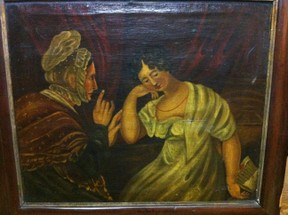 There's always something vaguely creepy about looking at Georgian courtship through modern eyes.
There's always something vaguely creepy about looking at Georgian courtship through modern eyes.













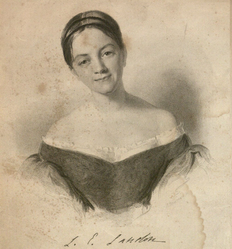

 St Tydecho's Churches in West Waleson 09/03/2014
St Tydecho's Churches in West Waleson 09/03/2014
 Goodies for an Outlander Premiere Partyon 03/06/2015
Goodies for an Outlander Premiere Partyon 03/06/2015
 Holocaust Memorial Day Interview with Rainer Höss, Grandson of Rudolf Architect of Auschwitzon 01/24/2015
Holocaust Memorial Day Interview with Rainer Höss, Grandson of Rudolf Architect of Auschwitzon 01/24/2015
 Romantic Valentine Gifts for an Outlander Fanon 01/16/2015
Romantic Valentine Gifts for an Outlander Fanon 01/16/2015

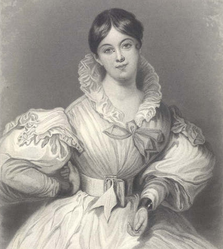
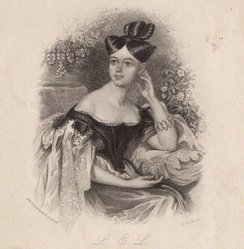
Comments
I found my way here looking for information about Hans Place in Sloane Square, and I've learned so much more - thank you! I don't suppose you could point me in the direction of a reliable source about everyday life at Hans Place?
Now off to find this marvellous poetry, LEL and Mrs Rowden both :)
She did it in illustration of the picture, which was reproduced in 1833 for that purpose. I'm really pleased to find someone taking an interest in the subject and period though! Thanks for the heads up.
The picture by Richter is an illustration from Sir Walter Scott's The Antiquary, published in 1816, and has nothing to do with a 14-year-old Landon, who published her poem The Love Letter in 1833 when she was 31.
She's certainly got my interest! I think I'm ready to write part two now, but it's late, so I'll leave it tomorrow.
Scandal, romance--I can't wait to see more! She is definitely an intriguing person!
I really liked Mrs Rowden too! I should have pulled her out and given her an article of her own.
I've been reading L's poems, and biographies, and critiques, and blah blah insertions about what it all meant, all day. I've barely written a word, but right now my mind is so full of this stuff. I'm in Skype if you have 10 mins to talk poetry and Feminism.
I've not read enough of her poetry yet to pick one out. What I have read has been slightly hit and miss, but I also understand why. Some bits are amazing. L is definitely a genius. :)
I was almost more interested in Mrs Rowden here. Really kick-ass woman, I think.
Do you have a favorite poem from her?
(Also, I couldn't help but notice a few small details, such as 'genius' and a pseudonym of 'L' >.>)
Yay! Then that means that my work here is well and truly done. And the second part will be coming when I've finished researching it (and getting much side-tracked into interesting detours).
I see :) You certainly work your magic on your research. It entices me to read things outside my radar, which is a great thing.
Finished reading this one. Looking forward to Part II.
I did that once with an Irish article and it looked so very messy. Besides, I'm not writing it as an academic piece per se, at least not any more than I'm naturally inclined to do after all that training!